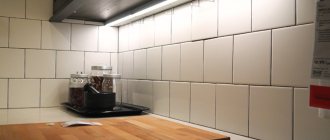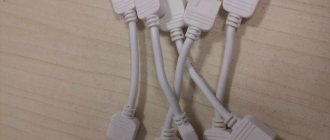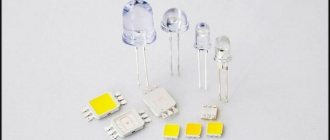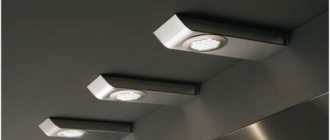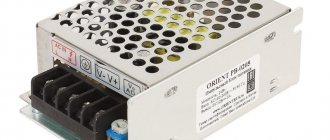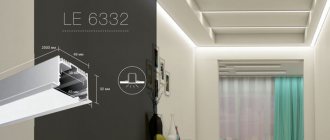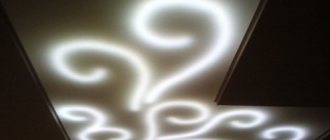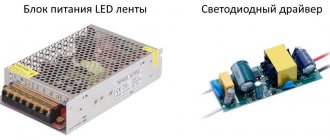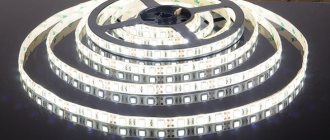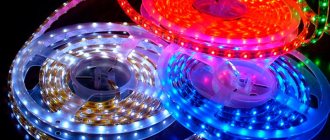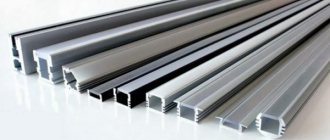LED lamps have a large number of advantages. Such devices are characterized by durability, low electricity consumption and directional light output. LED strip allows you to provide light of the required brightness to a part of the room that needs decorative lighting or is used as
primary or additional lighting for a workplace or section in the kitchen. You can install the LED profile yourself, subject to the necessary electrical safety standards.
Factory profile fastening options
What is a profile for LED strip?
A profile is a specialized structure for placing an LED strip, made of aluminum, sometimes of plastic.
It provides reliable fastening of a flexible printed circuit board with LEDs and creates an optimal temperature regime for the operation of light-emitting diodes. The front part of the profile is covered with a light-diffusing matte screen, which forms a uniform light flux. Thanks to the diffuser, a uniform luminous strip is created without pronounced luminescence maxima. The ends of the profile rail are terminated with plastic side plugs.
LED difference
The LED itself consists of a housing in which emitting crystal chips are placed. The whole thing is filled with compound on top. The chips in cheap and expensive tapes are different.
What are the differences?
in size
In inexpensive tapes, they are smaller in size and, accordingly, produce a lower luminous flux.
conductive thread material
For high-quality ribbons they are gold. In standard versions they are made of alloys. Over time, under the influence of a phosphor or compound, the alloy threads are destroyed. Therefore, the service life of the LED itself is shorter.
quality of phosphor filling
For the elite class, it has less impact on the chips themselves and their contact does not affect the service life of the LED.
difference in chips
The so-called binning. This is when neighboring LEDs, due to different crystals, can shine with different fluxes and shades.
How can you see all this clearly in the store? Unfortunately, this cannot be done visually without applying voltage. But by turning on the tapes in parallel, one next to the other, you can see the difference.
The premium LED will appear to be slightly larger. Actually this is not true. Both may have SMD3528, but the high-quality version will simply have a larger chip. Because of this, this impression is created.
But it’s best to look not at the LEDs themselves, but at the surface illuminated by them. LEDs from different companies may have different scattering angles (according to the standard it should be 120 degrees). A chip with a smaller angle (90-100 degrees) will visually seem much brighter to you, although in fact this will not be the case.
Types of LED profile
Overhead
– mounted on concrete/plasterboard ceilings and walls, placed in under-ceiling niches, covered with a decorative cornice. The aesthetic appearance allows you not to cover the LED profile at all, which looks like an overhead linear lamp.
Angular
– installed at the junction of the ceiling and the wall, along the perimeter of the kitchen unit, wall niche, shelving.
Mortise with flanges
– built flush into a plasterboard or Armstrong tile ceiling. The implementation is complex due to the need to prepare mounting grooves. It can be built into concrete floors, wooden walls and ceilings by making grooves.
Application area
The main purpose of these elements is to install a diode-based tape. It comes in different types (plastic, aluminum) and is used to organize lighting in different areas. This could be the ceiling, walls, corners of the room. In addition, by choosing one of the design options, it is possible to use it as a surface-mounted lamp.
The design of some models (mortise version) allows profiles to be embedded in different surfaces, including when organizing the lighting of steps, and also installed outdoors (as lighting in landscape design). This is facilitated by the type of material – anodized aluminum, which is not subject to corrosion. In a word, they can be used as decorative elements, and also perform protective functions when installing strip-type lamps.
Possible installation methods
Pasting
– applies only to corner profiles. This is done using special double-sided tape or special glue, for example, “liquid nails”.
Self-tapping screws, screws with dowels
– the most common option, providing better fastening reliability.
Holders
– usually used by professional installers. Fastening accessories are not universal, but differ in purpose for different types of profiles:
For invoices
For corners
Safety precautions
- All installation work is carried out with the power turned off.
- When installing the SDL on a conductive surface, the attachment point is pre-insulated.
- Observe polarity when connecting contacts; multi-colored conductors help with this.
- Do not touch exposed conductive parts while the power is on.
- Do not expose the board to mechanical stress (kinks).
- Follow electrical safety rules when working with 220 V networks.
- Related Posts
- What are gas discharge lamps
- Where to donate fluorescent (mercury) lamps
- Why are chokes (ballasts) needed for fluorescent lamps?
Sequence of actions when installing a profile with your own hands
Installing a profile for an LED strip is easy to do yourself. The main thing is to choose the right model for your task.
- determining the route for placing the LED strip;
- marking lines to install the profile;
- cutting profile slats to measured lengths;
- fixing the profile on surfaces in the most optimal way;
- installation of the LED strip in an aluminum profile (on the adhesive layer on the back side of the printed circuit board);
- installation of a light-diffusing screen and end caps.
Beautiful examples in the interior
LED lighting paired with a suspended ceiling can create a unique atmosphere and make your interior unique. You can realize your own ideas and surprise your guests.
Such lighting looks beautiful in a children's room. The tape plays not only a decorative, but also a practical role. Since most babies are afraid to fall asleep in the dark, you can leave a “starry sky” on the ceiling, which will protect your child.
The lighting inside the ceiling is beautiful and unusual. Choose original combinations that will draw unusual patterns or even pictures above you. Such designs should be invisible in the main lighting and look impressive in the evening.
Many people choose soaring ceilings. This solution creates the illusion that the ceiling is weightless and floating above you. Rooms decorated in a similar style have an airy feel and immerse you in an atmosphere of mystery.
Installing lighting in a plasterboard niche is a common option that will never lose its position. Lighting creates a unique effect that all your guests can appreciate.
For multi-level structures, LED lighting is considered the best option.
To learn how to properly install an LED strip, see the following video.
Diffuser
A light-diffusing element or light screen is necessary to uniformly distribute the light flux or redirect it to the illuminated surface. Most often it has the shape of a rectangular box or hemisphere. Made from polycarbonate. Installed inside the profile or on protruding external sides. Depending on the purpose, type of lamp and design features of the illuminated objects, diffusers with different light transmittance are used. Matte, compared to transparent ones, block up to 40 percent of the light flux, but make it softer and more comfortable for vision. Semi-matte screens make light less bright by about a third.
Price
The cost of a profile for an LED strip depends on its size and shape, color, material from which it is made, the popularity and reputation of the brand, the country of manufacture and the country of the brand holder. Prices for profiles may differ by an order of magnitude. The simplest overhead profiles, designed for attaching one strip with low-power LEDs, usually cost from 100 to 200 rubles. The price of profiles that are used for lighting steps, outdoor advertising, and pendant lamps can reach up to 10-15 thousand rubles.
Budget options
Despite the fact that the profile is an important but auxiliary element, its cost is comparable to the cost of the tape itself. In the case of a limited budget and hidden placement of lighting elements, a metal channel for installing drywall or plastic channels for external electrical wiring can be used to replace the branded profile. They have a noticeably lower cost, which, in some cases, completely compensates for the shortcomings that arise during installation or operation.
